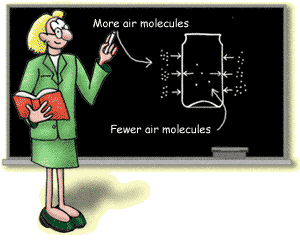
|
What makes the can collapse, Dr. Millie? |
|
|
However, the vacuum in your can barely begins to be like the vacuum of space! A true vacuum is a space with absolutely nothing in it--not even a single molecule of air! As you can see from your test, a container made of this material bends and wrinkles when the air outside pushes harder than the air inside. With spacecraft fuel tanks, the vacuum is on the outside, rather than the inside. So to properly test the fuel tanks on the ground you need to be able to create a vacuum outside of them. This is very hard to do in your kitchen! You need a vacuum test chamber--too expensive for the average home! Engineers and scientists are inventing new technologies every day. Some of these inventions help to make the spacecraft smaller and lighter, or faster and more fuel-efficient, or easier to operate from Earth. Some of these inventions help scientists make better measurements of conditions in space or take better pictures of Earth from space. Some make it possible to detect the tiniest changes in the position or brightness of a distant star. Engineers first test new spacecraft technologies in laboratories on Earth that try to copy conditions in space. But even these space labs can't copy exactly what the spacecraft and measuring devices may find in space. Airplane builders send new types of airplanes on test flights before using them to carry passengers. Likewise, NASA's New Millennium Program tests new spacecraft technologies in space before sending them out on more expensive scientific missions. One spacecraft can carry several new technologies into space and test them all at once. If one doesn't work the way it should, we've learned something valuable and can fix it before using it for a valuable mission of discovery. |
|
|
|
|||||

 The can
collapses because you have made a partial vacuum inside the
can. This means the air inside the can is thinner (less
dense) than the air outside the can.
The can
collapses because you have made a partial vacuum inside the
can. This means the air inside the can is thinner (less
dense) than the air outside the can. 




